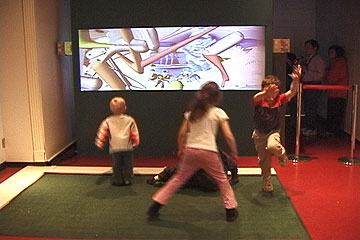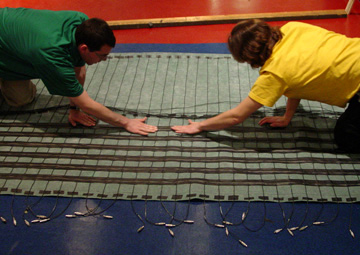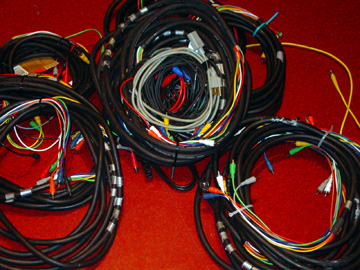| Stomping
Ground is a permanent installation at the MIT
Museum consisting of a musical carpet and a projection of live video
with superimposed blobs. Kids seem to love it. It is a collaboration between
Joe Paradiso of the Responsive
Environments group, who made the carpet and the radars, Kai-yuh
Hsiao of the Cognitive
Machines group, who wrote the music, and Simon
Greenwold of the Aesthetics + Computation
group, who designed and programmed the visuals.
See a movie of Stomping Ground
in action.
Responsive Environments' page
about the carpet.
|
|
What it
does
The carpet tracks the location and intensity of footfalls with a grid
of sensors. Doppler radars mounted on the sides of the projection wall
track the overall direction and intensity of upper-body motion. This information
is used to create a musical composition that has two modes: one has a
richly layered new-agey sound, and the other is agressively percussive.
The same data is fed to the graphics system, which produces blobs that
grow upwards from the locations of footsteps. The blobs are superimposed
on a live video image showing the legs and feet of people on the carpet
(whole bodies of very small people). The video and the forms in it are
affected by a virtual wind force, which is increased by stomping or upper-body
activity.
|
|

At the opening of the piece on 4.28.02 there were 461 visitors (many of
them small), who came and played.
|
|
What it
explores
Stomping Ground is a piece about mappings. The same data stream,
taken from the natural body motions of museum visitors is used to create
two totally different responses—music and graphics, which are blended
back into a single experience. It demonstrates that data is only data
and how it is digested depends entirely on the form of its presentation.
It also explores different levels of user control and influence. Certain
actions provoke obvious changes in the system, but others, such as swinging
arms, have a subtle effect, which users will only appreciate if they give
the piece some time and attention. It is designed to reward exploration.
|
|

A child becomes engrossed watching reflective blobs that have arisen from
his movements.
|
|
Technical
details
The
underside of the carpet is lined with a 34X14 grid of piezoelectric wires.
These deliver a tiny electric impulse when deformed by foot pressure.
These signals are picked up, amplified, and transformed into a MIDI data
stream that is fed separately to the music and graphics computers. The
radars send out a 2.4GHz wave and determine motion levels by the Doppler
shift of the returning wave. This information is folded into the same
MIDI stream.
The blobby forms came from some work I had done previously on integrating
real and virtual space. (See Installation.)
|
|

Simon (left) and Ollie tape the piezoelectric wires to the underside of
the carpet.
|
|
Credits
Project
Coordinator: Stephanie Hunt
Hardware Creator: Joe Paradiso
Composer: Kai-yuh Hsiao
Visuals/space designer: Simon Greenwold

|

|

The cables that transmit the signals from the wires under the carpet to
the box that amplifies them and turns them into a MIDI stream for the consumption
of the music and graphical systems. |
![]()
